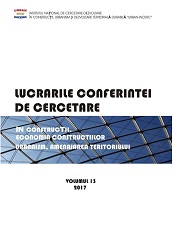The whole periodic city "Rosia Poieni"
The whole periodic city "Rosia Poieni"
Author(s): Denes Joo, Gyula LAZAR
Subject(s): Physical Geopgraphy, Human Geography, Regional Geography, Environmental Geography, Applied Geography
Published by: INCD URBAN-INCERC
Keywords: Rosia Poieni; periodic; city
Summary/Abstract: In order to remedy the catastrophic ecological situation created by the mining work „ROȘIA POIENI” in the Apuseni Mountains, we propose the realization of a complex project with this name – unlike to „periodic city” notion initiated by the architect Ric Stephens – based on a radial-spiral „whole periodic” structured masterplan on the surface and on a spatial master of „ant-hill” type in the depth, in correlation with the restoration of the cruelly destroyed surroundings.In the context of the archological vision initiated by the architect Paolo Soleri around 1970 (Archology=Architecture+Ecology), we propose the realization of a conical pyramidal city over this career, thus redefining the original form of this mountain. In a broader view, the problem of destroying and restoring this mountain is of cosmic significance, the Apuseni Mountains with the Roșia Poieni Peak - as the projection of the Ecliptic Center, marked by the Nebula NGC 6543 called Cat’s Eye, inside the Carpathians as projection of the Dragon Constellation - constituting a neuralgic point of the whole cosmic structure in Our Galactic Zone.The dextrogire (right rotating) basic spirals around the center of the 8 axes, namely 16 semi-axes of the radial-spiral masterplan on the surface, connected to the levogire (left-rotating) spirals on the depth form an energetic vortex, as main axis of the proposed building-city, in the whole height of the whole spatial structure. The spatial master in the depth will in principle pursue the created levels of the career, with a traffic network similar to that of the surface, correlated with the ventilation system. The functional zoning will be determined during the elaboration of grounding studies, but in principle the residential areas (dwellings, institutions, services, green spaces, recreation) will be located on the surface, and the production areas (industrial and agricultural units, warehouses, communal units) in the depth. The realization of this building-city does not exclude the possibility of mining works, but with the initially projected technology, through an electrolytic process with deep drillings. Agricultural production focuses primarily on growing mushrooms, including processing and packaging sections, as well as other more effective plant and livestock products.Considering that archologies are proposed in the idea of reducing the impact with natural resources and does not require links to municipal or urban infrastructure in order to function, this idea can be extended to all similar careers.
- Page Range: 23-30
- Page Count: 8
- Publication Year: 2017
- Language: English
- Content File-PDF

